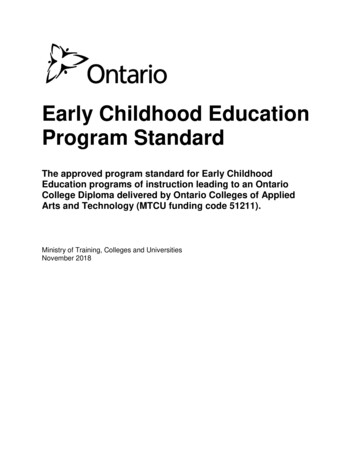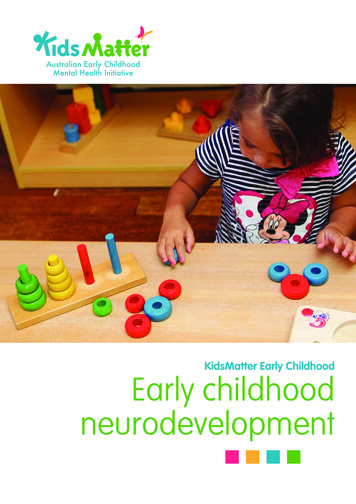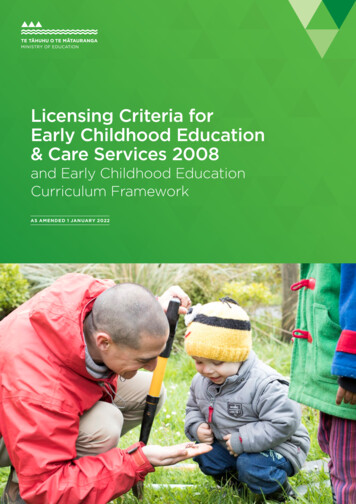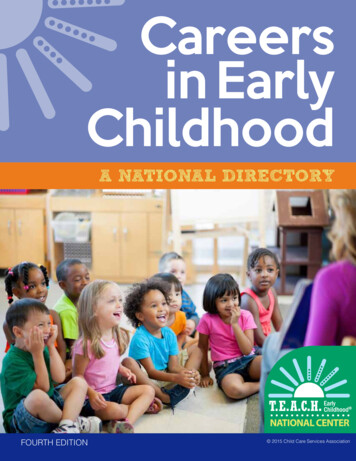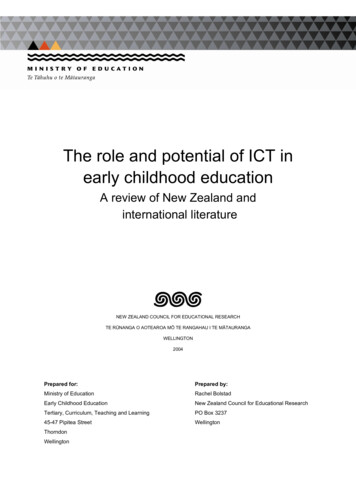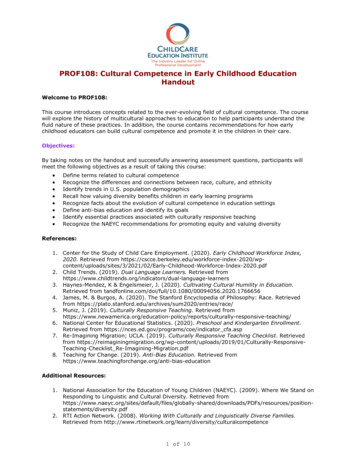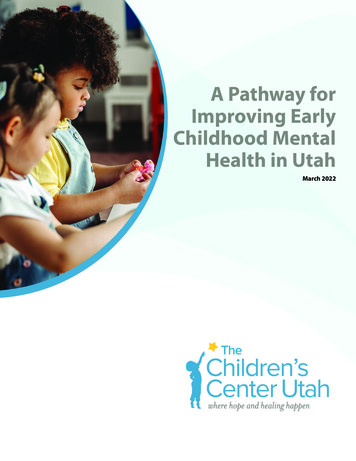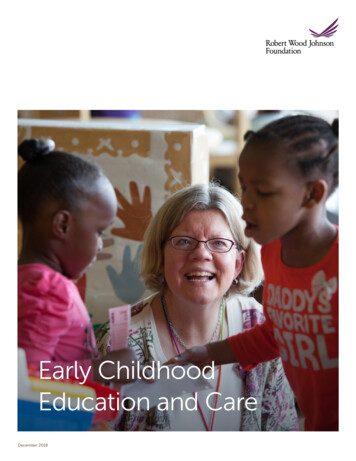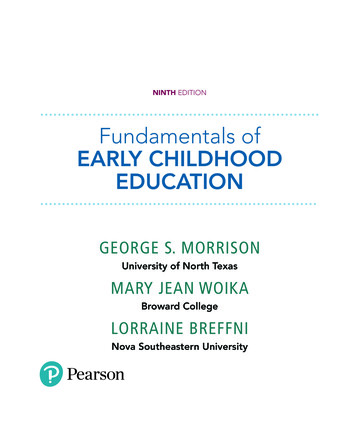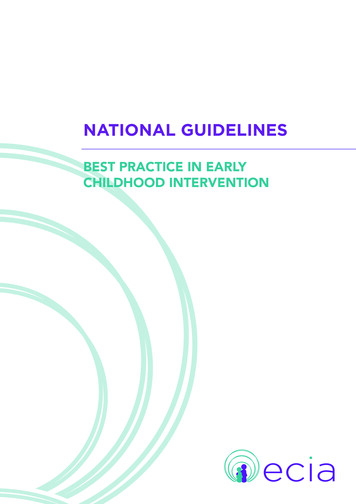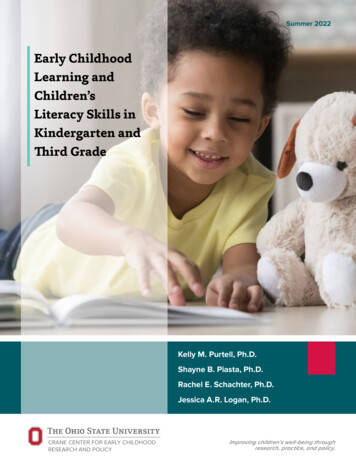
Transcription
Summer 2022Early ChildhoodLearning andChildren’sLiteracy Skills inKindergarten andThird GradeKelly M. Purtell, Ph.D.Shayne B. Piasta, Ph.D.Rachel E. Schachter, Ph.D.Jessica A.R. Logan, Ph.D.CRANE CENTER FOR EARLY CHILDHOODRESEARCH AND POLICYImproving children’s well-being throughresearch, practice, and policy.
Children’s code-focused skills, such as letter knowledgeand phonological awareness, and language skills duringearly childhood are key to their later reading success.As such, most states, including Ohio, include bothcomponents in their early learning standards. However,little research has examined how these skills predictperformance on school-based assessments. Furthermore,how learning gains in these skills during children’s timein early educational settings predicts later success onthese assessments is unknown, but key to understandingthe role of early childhood education.In this white paper, we examine how children’s skills in the fall of their earlychildhood education (ECE) year and gains in these skills across the year predicttheir performance on kindergarten and Grade 3 measures of literacy and readingachievement. Relying on data from over 700 children across the state of Ohio, wefind that while children’s initial levels of code-focused and language skills predictedtheir kindergarten literacy skills, only gains in their code-focused skills predicted thisoutcome. We also find that while initial levels of code-focused and language skillspredicted Grade 3 reading achievement, gains in these skills were not predictive.Taken together, these findings suggest that children’s skills and skill developmentduring early childhood education shape their later reading performance but that theirinfluence is stronger in kindergarten than in Grade 3.2
Background & AimBoth word recognition and language skills are major components of readingachievement (Gough & Tunmer, 1986; Language and Reading Research Consortium,2015a), and skills related to both of these components are reflected in Ohio’s K-12English Language Arts learning standards and Plan to Raise Literacy Achievement(Ohio Department of Education, 2017, 2020). However, development of such skillsbegins well before formal school entry. During early childhood, children developimportant code-focused skills foundational for later word reading, such as letterknowledge and phonological awareness, as well as language skills foundational forreading comprehension (see Figure 1; Hjetland et al., 2020; National Early LiteracyPanel, 2008).Figure 1. Code-focused and Language Skills Developed During ECELetter KnowledgePhonological AwarenessLanguage SkillsThe ability to identify letters byname and/or sound (Georgiou etal., 2012; Piasta, 2014)The ability to hear andmanipulate sounds in words(Herrera et al., 2021; Phillips etal., 2008)Vocabulary, syntax, anddiscourse-level skills thatallow children to express andunderstand spoken language(Language and ReadingResearch Consortium, 2015b)In line with K-12 standards, both code-focused and language skills are emphasizedin Ohio’s policies related to early childhood education. Both are included in the stateEarly Learning and Development Standards (Ohio Department of Education, 2012)and assessed as part of its Early Learning Assessment and Kindergarten ReadinessAssessment (Ohio Department of Education, 2016; WestEd, n.d.). Strengthening supportsfor these skills during early childhood is one of the state’s strategies for improvingreading achievement and meeting the Third Grade Reading Guarantee (Ohio Departmentof Education, 2020). Recently, however, there has been debate among researchers,policymakers, and practitioners as to the relative benefits of emphasizing code-focusedversus language skills in early childhood education. Some have argued that early boostsin code-focused skills, like letter knowledge, fade out whereas boosts to more complexskills, like language, are more likely to have lasting benefits (Bailey et al., 2017, 2020).3
To better understand this issue within the context of Ohio, we examined how letterknowledge, phonological awareness, and language learning demonstrated bychildren enrolled in Ohio early childhood education programs predicted their laterperformance on the state Kindergarten Readiness Assessment-Literacy (KRA-L) andthe Grade 3 Ohio Achievement Assessment (OAA) Reading subtest1 (Logan et al.,2022). Although prior studies have shown associations between code-focused andlanguage skills with later reading (Hjetland et al., 2020; National Early Literacy Panel,2008), this work has typically measured children’s skills at one point during earlychildhood. In contrast, we also examined the learning gains made by children acrossThe KRA-L and OAA Readingsubtest were the precursors tothe current state KindergartenReadiness Assessment (KRA)and Ohio’s State Test (OST)in English Language Arts andthe assessments completedby the children for whom wehad early childhood data.Both the KRA-L and currentlyused KRA (language andliteracy domain) measureskills in rhyming, alliteration,letter identification, speaking,and listening. The KRA alsoincludes writing skills whichwas not a part of the KRA-L.Additionally, a comparabilitystudy showed that the twoassessments are comparable(Ohio Department ofEducation, 2016). Both theOAA Reading AchievementTest and OST EnglishLanguage Arts subtest assesschildren’s ability to read andcomprehend texts.1a year of early childhood education. That is, how much do children learn across theschool year, regardless of where they started? This helps us understand how earlylearning relates to later achievement. Our use of authentic, school-based kindergartenreadiness and Grade 3 reading achievement tests are also important, as children’sperformance on these tests have real-world implications for children and their families,early childhood professionals, and policymakers (Ansari & Purtell, 2018).By looking at initial skills and learning gains, we were able to examine both howchildren’s starting point at the beginning of the ECE year and changes in skills acrossthe year are independently associated with their later performance on the KRA-L andGrade 3 OAA Reading subtest. We looked at both because some children may startwith higher skills but make small gains across the ECE year. Conversely, some childrenmay start with lower skills but make large gains during the ECE year. By examiningthem separately, we were able to capture how learning gains across one year of ECEshape later reading achievement. By looking at gains, we are better able to understandhow the learning children achieve during their time in ECE, in addition to the skills thatthey bring to their ECE experiences, is associated with their later literacy skills.In this work, we asked:Do initial levels of and learning gains in code-focused andlanguage skills during early childhood education matterfor performance on later school-based assessments?4
Data & MethodWe capitalized on data collected for a prior, statewide project (Piasta et al., 2020;Piasta, Justice, et al., 2017; see Piasta, Mauck, et al., 2017 for a brief summary). Thepreregistered study protocol for the current study is available at https://osf.io/f79ms,and further details of the study are available at https://edarxiv.org/sz7tn (Logan et al.,2022).The current study involved 725 children who were enrolled in ECE programs withinOhio, matriculated into Ohio public elementary schools, and for whom the OhioDepartment of Education could provide KRA-L data2. All children had parental consentfor study participation and were at least 4 years old when first assessed. Children’sparents reported that children were able to speak and understand English and didnot have profound disabilities; these requirements were in place to ensure thatassessments were appropriate for participating children. Descriptive information forthese children is provided in Table 1.2Descriptive information isprovided on the full analyticsample of 725 children, forwhom KRA-L data wereavailable. The sample sizedecreased to 606 childrenwhen considering the Grade 3English Language Arts subtestof the OAA as the outcome.Table 1. Descriptive information for children included in the study (as reported by parents during ECE).DESCRIPTIVE INFORMATIONGender is boy% OR nicityHispanic/LatinxChild has Individualized Education Plan (IEP)5%17%Parent EducationLess than High School Degree6%High School Degree16%Technical Training beyond High School10%Some College (No Degree)26%Associate’s Degree14%Bachelor’s Degree14%Graduate Degree13%Family Income-to-Needs Ratio (range from 0.06 to 6.45)1.95
Children were enrolled in 253 different ECE classrooms across urban (25%), suburban(31%), and rural (33%) areas of Ohio (note that percentages may not sum to 100%because some information was not reported for all classrooms). Most classroomswere located in public schools (46%) or early childhood centers (49%), and 34% wereaffiliated with Head Start. Teachers in these classrooms were primarily female (96%),White (83%), and non-Hispanic/Latinx (99%). Teachers’ highest education levelsincluded a high school diploma (2%), associate’s degree (20%), bachelor’s degree (18%),or graduate degree (24%). Teachers had an average of 12 years of teaching experience.Children completed a battery of assessments in the fall of their early childhood yearand again in the spring, so we could measure their learning gains. These includedassessments of letter knowledge, phonological awareness, and language skills (seeTable 2). We also followed children longitudinally as they matriculated into their publicelementary schools. As children completed kindergarten and Grade 3, we requested andreceived their KRA-L and OAA Reading data from the Ohio Department of Education.The KRA-L, given at the start of kindergarten, assesses children’s emergent literacy,speaking, and listening skills. The Grade 3 OAA Reading subtest, also completed in thefall, assesses children’s abilities to read and understand literary and informational texts.6
Table 2. Children’s Scores on all AssessmentsMOutcomesMinSDMaxKindergarten Readiness21.596.17Grade 3 Reading681.83 48.02329551830FALLSPRINGMSDMinMaxMSDMin MaxExpressive Vocabulary21.697.2003925.077.12040Sentence Structure14.504.1502216.503.81022Word Structure15.064.6402416.944.48024Alliteration Awareness3.272.470124.303.11012Rhyme 6.27 052Language: CELF:P2Phonological Awareness: PIPALetter Knowledge: PALSUpper & Lowercase Letter RecognitionNote. Raw scores are presented in the table; these were converted to z-scores for analysis.CELF:P2 Clinical Evaluation of Language Fundamentals Preschool-2 (Wiig et al., 2004); PIPA Pre-Reading Inventory of Phonological Awareness (Dodd et al., 2003); PALS PhonologicalAwareness Literacy Screening for Preschool (Invernizzi et al., 2004).3The final structural equationmodels, from which wederived the key findingsbelow, exhibited good modelfit (RMSEA .054, CFI .970, SRMR .047 for KRA-L;RMSEA .052, CFI .970,SRMR .048 for Grade 3 OAAReading subtest).Details of our analyses are provided in the preregistration and full study report4In the original statewideproject, classrooms wererandomly assigned to one ofthree conditions: languageand literacy professionaldevelopment workshopseries, language and literacyprofessional developmentworkshop series pluscoaching, or alternativeprofessional development.The original project showedminimal effects on classroompractices (limited to effects onphonological awareness andemergent writing instruction)and no effects on children’slanguage or literacy learning(Piasta et al, 2020; Piasta,Justice et al., 2017).(Logan et al., 2022). In brief, we analyzed the data using structural equation models.We first estimated a latent change model (McArdle & Hamagami, 2001; McArdle &Nesselroade, 2014), which allowed us to examine children’s initial levels of letterknowledge, phonological awareness, and language skills (i.e., in fall) as well astheir learning gains from fall to spring. We then expanded this model to predictchildren’s KRA-L and Grade 3 OAA Reading outcomes. All models accounted forthe non-independence of children nested in early childhood classrooms3 . We alsoconducted robustness checks and found the same key findings as reported belowafter controlling for children’s race, gender, age, family income-to-needs ratio, anddisability status; classroom child:teacher ratio; and randomly assigned condition fromthe original statewide project 4 .7
Key FindingsPredicting Children’s Performance on the Kindergarten ReadinessAssessment-Literacy (KRA-L)Our findings support the hypotheses that code-focused and language skills duringearly childhood are associated with children’s reading skills in elementary school,as captured by school-based tools in kindergarten and Grade 3. In combination,initial skills and learning gains in letter knowledge, phonological awareness, andlanguage accounted for 68% of the variance in children’s KRA-L scores. This supportsthe models of reading development that emphasize the importance of both earlycode-focused and language skills. Specifically, we found that children’s fall letterknowledge, phonological awareness, and language skills all significantly predictedthe KRA-L when included together in one predictive model.To aid in interpretation of our results, we provide the difference in scores on the KRA-L ofchildren who were one standard deviation apart on the focal predictors. Figure 2 visuallydepicts scores for these children. The dark and light teal lines in the left panel representtwo children who entered the ECE year with a one standard deviation difference in initialskills but made the same gains across the year. In the right panel, the dark and lightred lines represent two children who had the same initial skill level at the start of ECEdiffered by one standard deviation in the gains they make across the year.Figure 2. Visual Depiction of Childrenwith Differing Starting Skills in ECE8Figure 3. Visual Depiction of Childrenwith Differing Gains in Skills Across ECE
In Figure 4, we show the difference in KRA-L points between these children. Fortwo children who were one standard deviation apart in initial letter knowledge (teallines in Figure 2), the child who scored higher would score 2.63 points higher on theKRA-L. For children who were one standard deviation apart in initial phonologicalawareness, the child who scored higher would score 1.27 points higher on the KRA-L.Using the same paradigm for fall language, the child with the initially higher languagescore would score 3.24 points higher on the KRA-L.When we looked at gains as predictors of KRA-L performance (the red bars), wefound that children’s learning gains in code-focused skills, but not gains in language,also significantly predicted KRA-L scores. This suggests that children’s gains inthese emergent literacy skills, but not their gains in language skills, across the ECEyear are predictive of kindergarten literacy performance. For letter knowledge andphonological awareness, KRA-L scores depended not only on children’s initial skillsin the fall but also how much they learned during the early childhood year (e.g., anadditional 1.88 and 1.74 points, respectively, for every standard deviation more of gain).Figure 4. KRA-L Performance as Predicted by Children’s ECE Initial Skills and Skill GainsLetter KnowledgePhonological AwarenessLanguage Skills1.609
Predicting Children’s Performance on the Ohio AchievementAssessment (OAA) Reading SubtestSimilar to the findings for the KRA-L, we found that initial code-focused and languageskills and learning gains in these skills accounted for 42% of the variance in children’sGrade 3 OAA Reading scores5. As shown in the teal bars in Figure 4, we found thatchildren’s initial fall letter knowledge (standardized points 0.23) and languageskills (standardized points 0.29) significantly predicted their OAA Reading scores.However, their initial fall phonological awareness skills did not. This again suggeststhat children’s emergent literacy and language skills at the start of the early childhoodyear are predictive of long-term reading achievement.As depicted in the red bars in Figure 5, we did not find that learning gains in these skillsFor this model, we usedz-scores of children’s OAAscores instead of raw scores.5significantly predicted OAA Reading scores. This suggests that children’s initial skills, asopposed to changes in those skills, were most associated with long-term achievement.Figure 5. Grade 3 OAA Performance as Predicted by Children’s ECE Initial Skills and Skill GainsLetter Knowledge10Phonological AwarenessLanguage Skills
ImplicationsOur findings confirm the key role of early code-focused and language skills inpredicting children’s performance on both the KRA-L and Grade 3 OAA Readingsubtest. We found that children’s initial skills at the start of the ECE year and thelearning gains that they made across the year accounted for over two-thirds of thevariance in their performance on the KRA-L and almost half of the variance in theirperformance on the OAA Reading subtest.Children’s initial levels of all three skills (letter knowledge, phonological awareness,and language) at the start of the ECE year were predictive of their performance onthe KRA-L and two of the three skills (letter knowledge and language) were stillpredictive of performance on the Grade 3 OAA Reading subtest. This highlights thelong-lasting importance of children’s skills as they enter ECE. It also underscores theneed for investment in children’s birth to 3 experiences as these shape the initial skilllevels children demonstrate at the start of ECE (Love et al., 2005).Our findings also show that children who make greater gains in code-focused skills(letter knowledge and phonological awareness) during ECE score higher on theKRA-L. This suggests that children’s learning of code-focused skills during ECEcontinued to be demonstrated on the KRA-L, which was administered in the first fewmonths of kindergarten. Gains in language skills were not predictive but, as notedabove, initial language skills were. This may be because there was little growth inlanguage skills across the year: The average amount of children’s language gainsin this sample was 0.46 standard deviations. This is less than the typical growth inlanguage for children at this age (Schmitt et al., 2017).Lastly, and perhaps not surprisingly, children’s ECE skill levels and gains were bothmore strongly associated with performance on the KRA-L than the Grade 3 OAAReading subtest. This is consistent with literature that focuses on “fadeout” ofpreschool effects over time (Bailey et al., 2017). In other words, our findings show thatthe learning gains children make in ECE are predictive of performance in the shortterm (kindergarten) but fadeout over time (Grade 3). This suggests that disconnectsbetween the ECE and elementary school environments may prevent children fromsuccessfully building on the gains they made in ECE. Recent research has suggestedthat focusing on the alignment of children’s experiences in ECE classrooms and early11
elementary classrooms may reduce this “fadeout.” For example, increasing the useof small groups and centers in early elementary school may provide more continuityfor young learners (McCormick et al., 2020). Additionally, paying attention to therepetitiveness of ECE and kindergarten, and making sure that instruction aligns withchildren’s skill levels may also maximize children’s learning across the transition fromECE to early elementary school. For example, data from other states has shown asmuch as 37% of language and literacy content in pre-kindergarten and kindergartenis redundant (Cohen-Vogel et al., 2021).In conclusion, these results document the enduring associations between children’scode-focused and language skills in early childhood and later performance onschool-based assessments of literacy and reading comprehension. However, moreattention to children’s opportunities to develop these skills prior to, during, and afterECE is needed to ensure that children are ready and able to experience readingsuccess in elementary school and beyond.12
RecommendationsPractitioners/Teachers Provide multiple and wide-ranging literacy and language learning opportunitiesin early education settings that target both code-focused and language skills. Consider additional ways to support language learning in the classroom topromote greater gains, by creating opportunities for children to engage inextended conversations and teaching vocabulary throughout the day. Engage in meaningful communication across the transition from ECE toelementary school to ensure that children are receiving instruction thatextends, rather than duplicates, their learning opportunities.Policymakers Align early education and early elementary school practices and curriculato ensure learning opportunities match children’s skills. Provide professionaldevelopment programming to be delivered to ECE and early elementaryteachers. Enact policies that encourage communication across the transition to school sothat children are not receiving duplicate instruction. Invest in birth to 3 ECE programming as the foundations for later skills are laidthere.Researchers Consider including authentic, school-based assessments when examiningchildren’s learning and development in school settings to increase the policyrelevance of findings. Explore practices in ECE classrooms where children experience stronglanguage learning to better understand how to support this skill. Pursue more research regarding birth to 3 language and pre-literacy learning inECE contexts with a focus on how ECE teachers can set the foundation for laterliteracy and language development.13
ReferencesAnsari, A., & Purtell, K. M. (2018). Commentary: What happens next? Delivering on the promiseof preschool. Early Childhood Research Quarterly, 45, 177-182. 018.02.015Bailey, D. H., Duncan, G. J., Cunha, F., Foorman, B. R., & Yeager, D. S. (2020). Persistenceand Fade-Out of Educational-Intervention Effects: Mechanisms and PotentialSolutions. Psychological Science in the Public Interest, 21(2), 55-97. https://doi.org/10.1177/1529100620915848Bailey, D. H., Duncan, G. J., Odgers, C. L., & Yu, W. (2017). Persistence and Fadeout in the Impactsof Child and Adolescent Interventions. Journal of Research on Educational Effectiveness,10(1), 7-39. https://doi.org/10.1080/19345747.2016.1232459Dodd, B., Cosbie, S., McIntosh, B., Teitzzel, T., & Ozanne, A. (2003). Pre-Reading Inventory ofPhonological Awareness. PsychCorp.Georgiou, G. K., Torppa, M., Manolitsis, G., Lyytinen, H., & Parrila, R. (2012). Longitudinalpredictors of reading and spelling across languages varying in orthographic consistency.Reading and Writing, 25(2), 321-346. https://doi.org/10.1007/s11145-010-9271-xGough, P. B., & Tunmer, W. E. (1986). Decoding, reading, and reading disability. Remedial andSpecial Education, 7, 6-10. https://doi.org/10.1177/074193258600700104Herrera, S., Phillips, B. M., Newton, Y., Dombek, J. L., & Hernandez, J. A. (2021). Effectivenessof early literacy instruction: Summary of 20 years of research (REL 2021–084). p?projectID 4564Hjetland, H. N., Brinchmann, E. I., Scherer, R., Hulme, C., & Melby-Lervåg, M. (2020). Preschoolpathways to reading comprehension: A systematic meta-analytic review. EducationalResearch Review, 30, 100323. izzi, M. A., Sullivan, A., Meier, J. D., & Swank, L. (2004). Phonological Awareness LiteracyScreening for Preschool: Teacher’s Manual. University of Virginia.Language and Reading Research Consortium. (2015a). Learning to read: Should we keepthings simple? Reading Research Quarterly, 50(2), 151-169. https://doi.org/10.1002/rrq.99Language and Reading Research Consortium. (2015b). The Dimensionality of Language Abilityin Young Children. Child Development, 86(6), 1948-1965. https://doi.org/10.1111/cdev.12450Logan, J. A. R., Nicols, R., Piasta, S. B., Purtell, K. M. Schachter, R. E. (2022). Early childhoodlanguage gains, kindergarten readiness, and Grade 3 reading achievement. The OhioState University. https://edarxiv.org/sz7tnLove, J. M., Kisker, E. E., Ross, C., Raikes, H., Constantine, J., Boller, K., . & Vogel, C. (2005).The effectiveness of early head start for 3-year-old children and their parents: lessons forpolicy and programs. Developmental Psychology, 41(6), 885. , M. P., Weiland, C., Hsueh, J., Maier, M., Hagos, R., Snow, C., . & Schick, L. (2020).Promoting content-enriched alignment across the early grades: A study of policies &practices in the Boston Public Schools. Early Childhood Research Quarterly, 52, National Early Literacy Panel. (2008). Developing Early Literacy. National Institute for Literacy.www.nifl.gov14
Ohio Department of Education. (2012). Birth Through Kindergarten Entry Learning andDevelopment Standards. rly-LearningContent-Standards/Birth-Through-Pre K-Learning-and-Development-StandOhio Department of Eucation (2016). Ohio Comparability Study: Kindergarten RedinessAssessment and KRA-L. ss-Assessment-for-Teachers/KRA Comparability Jan2016.pdf.aspxOhio Department of Education. (2017). Ohio’s Learning Standards: English Language Arts.Retrieved February 25 from dsOhio Department of Education. (2020, January). Ohio’s Plan to Raise Literacy ing-in-Ohio/LiteracyPhillips, B. M., Clancy-Menchetti, J., & Lonigan, C. J. (2008). Successful PhonologicalAwareness Instruction with Preschool Children: Lessons from the Classroom. Topics inEarly Childhood Special Education, 28(1), 3-17. https://doi.org/10.1177/0271121407313813Piasta, S. B. (2014). Moving to Assessment-Guided Differentiated Instruction to SupportYoung Children’s Alphabet Knowledge. The Reading Teacher, 68(3), 202-211. https://doi.org/10.1002/trtr.1316Piasta, S. B., Farley, K. S., Mauck, S. A., Soto Ramirez, P., Schachter, R. E., O’Connell, A. A.,Justice, L. M., Spear, C. F., & Weber-Mayrer, M. (2020). At-scale, state-sponsored languageand literacy professional development: Impacts on early childhood classroom practicesand children’s outcomes. Journal of Educational Psychology, 112(2), 329–343. https://doi.org/10.1037/edu0000380Piasta, S. B., Justice, L. M., O’Connell, A. A., Mauck, S. A., Weber-Mayrer, M., Schachter, R.E., Farley, K. S., & Spear, C. F. (2017). Effectiveness of Large-Scale, State-SponsoredLanguage and Literacy Professional Development on Early Childhood EducatorOutcomes. Journal of Research on Educational Effectiveness, 10(2), 354-378. a, S. B., Mauck, S. A., Schachter, R. E., Spear, C. F., Farley, K. S., Weber-Mayrer, M., Justice,L. M., & O’Connell, A. A. (2017). Assessing Preschool Professionals’ Learning Experiencesin Ohio: What Have We Learned? [White Paper]. Crane Center for Early ChildhoodResearch and Policy, The Ohio State University.Schmitt, M. B., Logan, J. A., Tambyraja, S. R., Farquharson, K., & Justice, L. M. (2017).Establishing language benchmarks for children with typically developing language andchildren with language impairment. Journal of Speech, Language, and Hearing Research,60(2), 364-378.WestEd. (n.d.). Ready for Kindergarten: Early Learning Assessment Development rs/ELA-DevelopmentReport Final.pdf.aspxWiig, E. H., Secord, W. A., & Semel, E. (2004). Clinical Evaluation of Language FundamentalsPreschool (2nd ed.). Harcourt Assessment.15
Author NoteThe research reported here was supported by the Institute of Education Sciences, U.S. Department ofEducation, through Grants R305A190029 to The Ohio State University and the University of Nebraskaat Lincoln and R305E100030 to The Ohio State University. The opinions expressed are those of theauthors and do not represent views of the Institute or the U.S. Department of Education. We thankLaura Justice, Ann O’Connell, Dennis Sykes and the Early Childhood Quality Network, and the OhioDepartment of Education, including its Office of Early Learning and School Readiness, for their criticalroles in the original APPLE project. We also thank Robert Nichols for his analytic support and CathyKupsky for designing this paper.The recommended citation for this paper is:Purtell, K. M., Piasta, S.B., Schachter, R.E., Logan, J.A.R., (2022). Early childhood learning andchildren’s literacy skills in kindergarten and third grade. Crane Center for Early Childhood Researchand Policy, The Ohio State University.C R A N E C E NTE R FO R E A R LY C H I LD H OO D R E S E A RC H A N D P O LI CYThe Crane Center for Early Childhood Research and Policy, in The Ohio State University’s College ofEducation and Human Ecology, is a multidisciplinary research center dedicated to conducting highquality research that improves children’s learning and development at home, in school, and in thecommunity. Our vision is to be a driving force in the intersection of research, policy, and practice, asit relates to children’s well-being. The activities of the Crane Center for Early Childhood Research andPolicy are supported in part by a generous gift of the Crane family
Early Learning and Development Standards (Ohio Department of Education, 2012) and assessed as part of its Early Learning Assessment and Kindergarten Readiness Assessment (Ohio Department of Education, 2016; WestEd, n.d.). Strengthening supports for these skills during early childhood is one of the state's strategies for improving
